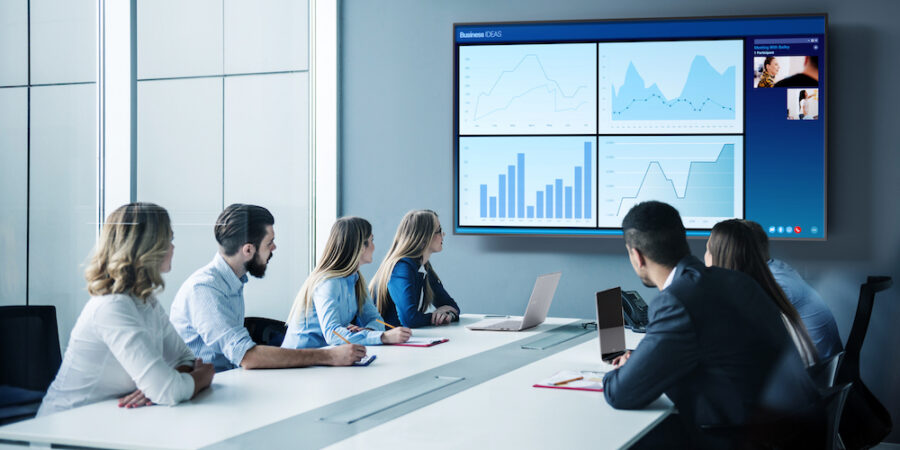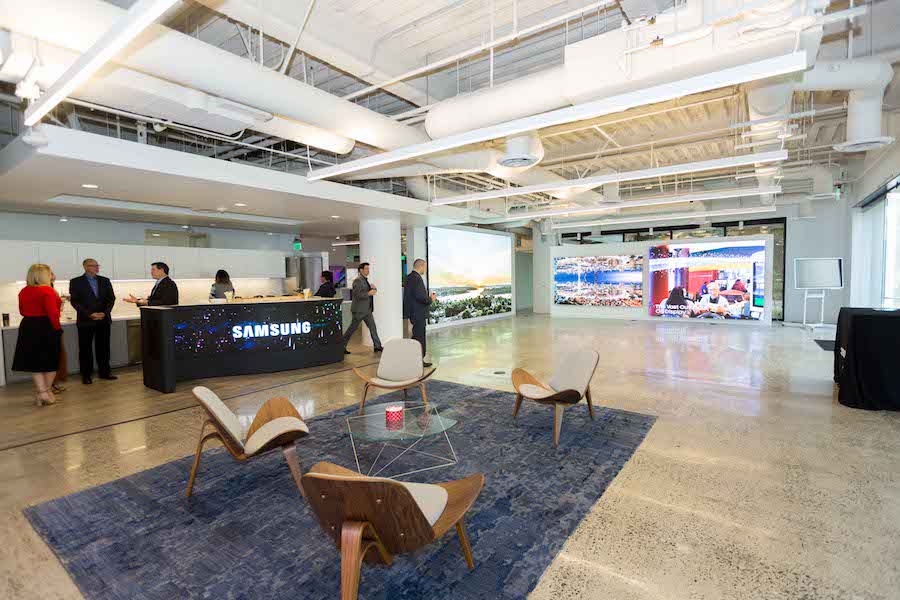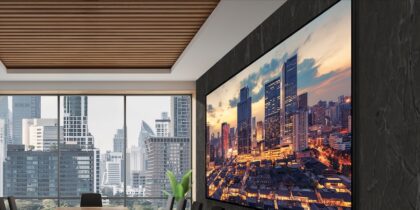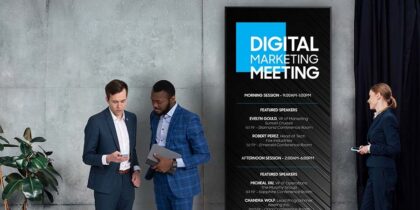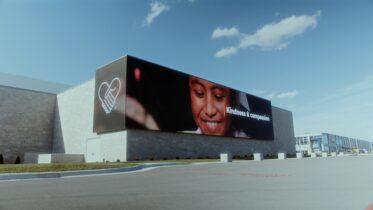Offices and other workplaces are operating differently — possibly forever — due to the uncertain times we’re in, and digital display technology is taking a central role in both managing and communicating these new normals.
Evolved workspaces and routines are driven in part by government orders and restrictions, but also by employers who understand the importance of maintaining safe, healthy working environments.
Let’s walk through how technology can communicate change and help minimize the risk between colleagues, customers and business partners — across different workspaces and throughout their workdays.
Outside
Communications on everything from health safety guidelines (such as mandatory use of face masks) to operating hours start from the moment staff and building guests arrive outside.
Display technology can provide key messages in a variety of ways:
- Dual-sided, high-brightness displays mounted in outside-facing windows can show different messaging on the inside-facing side.
- Outdoor-rated displays in free-standing totem enclosures on sidewalks and building plazas are easily readable even under midday glare.
- Direct view LED displays mounted on building facades are visible not only to those in the parking lot but to passing pedestrians and motorists.

Entryways
Once inside a lobby, reception area or designated employee entrance, building operators have several goals:
- Communicating recent changes and new guidelines
- Screening for illness (via temperature checks)
- Enforcing physical distancing
- Reminding workers and visitors of vaccine requirements and how to verify vaccination
Smart displays fixed to walls or temporarily positioned at entrances can effectively communicate key information, such as reorganization of offices and workstations to create safe gaps between workers. These displays can also remind everyone — more effectively than paper handouts or emails — of the value of safety measures such as masks and thorough hand-washing, as well as the critical need for staff to stay home if they develop any illnesses.
Modernize your workplace with digital signage
Explore how corporate offices are producing dynamic, engaging content for workers and clients alike. Download Now
Buildings of all kinds are continuing to use body temperature scanners as a first measure to screen staff and visitors. Camera systems can quickly read approaching people and flag those who may be running a fever. Screens can relay that flag to reception or building access desks so that staff can proceed accordingly. In some cases, those scanners may be directly tied to access control systems like digital gates and turnstiles, blocking a person’s entry if they have a high body temperature.
In large facilities, screens can communicate changes such as which areas are now off-limits and which areas have been given safety upgrades, like reduced capacity.
Displays positioned in key areas, like entrances, can use artificial intelligence (AI)-based computer vision software to analyze real-time video feeds, measuring the physical distance between people and displaying instant messaging that encourages people to spread out. These displays can work in tandem with technologies like smartwatches that measure personal distancing in real time and send notifications directly to people’s wrists.
Screens in the elevator lobbies can also outline capacity limitations that are more focused on distancing than weight.
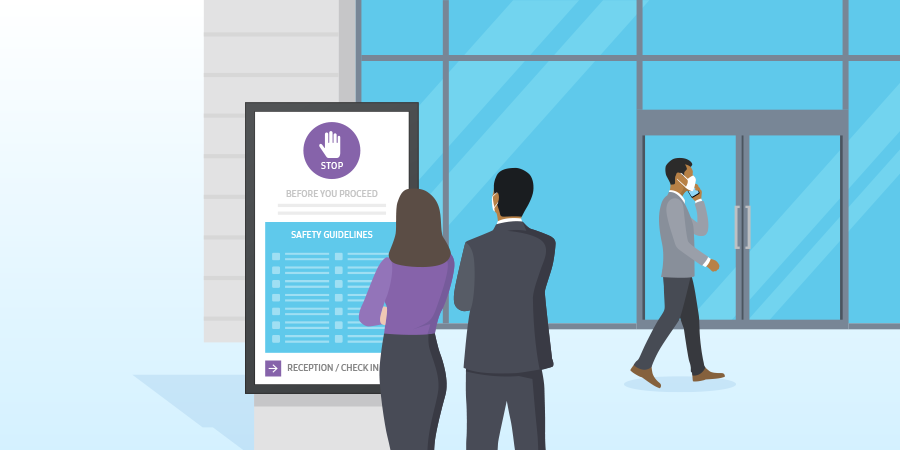
Working areas
As restrictions lift and employees return to their offices, the space will work differently. Some open office plans that packed workers into long rows in communal areas are being significantly rearranged to create distance.
Some colleagues’ work-from-home (WFH) arrangements may become permanent. This means fewer assigned workstations and more “hot” desks — working spaces assigned day to day and available on a first-come basis. Displays linked to desk assignment and management software can eliminate what could be chaos and conflict by using data and sensors to visually communicate what’s booked, what’s available and where.
WFH also elevates the importance of remote meeting and collaboration tools in both formal and informal meeting spaces. Everything from planning meetings to sales presentations is being done via online conferencing, so tools that allow for seamless setup, sharing and portability have become mission critical.
Screens are also effective at providing wayfinding for larger-footprint environments. They can list the availability of meeting and huddle spaces and even enable on-the-spot reservations at a meeting room doorway.
Even pre-pandemic, digital signage technology was already seeing widespread adoption in workplaces because of its ability to communicate everything from HR messaging to real-time business indicators far more effectively than conventional tools like notice boards, intranets and company email blasts.
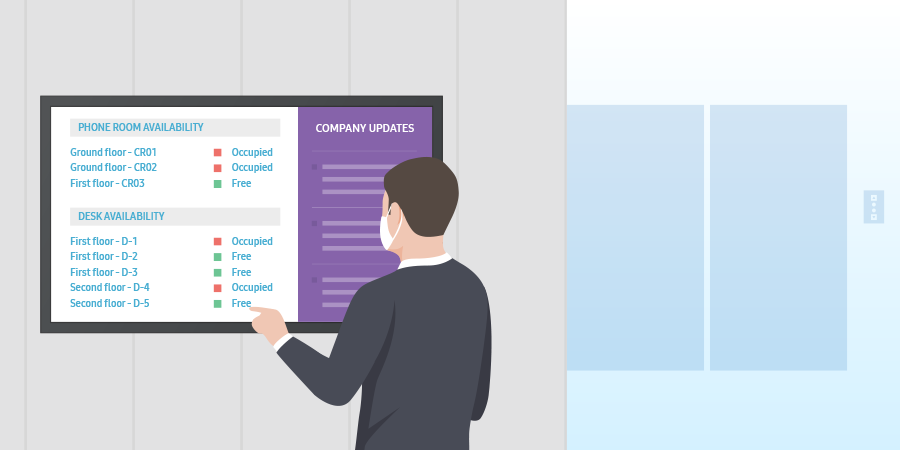
Break areas
Workplace changes extend all the way into spaces like dining areas, break rooms, change rooms and fitness facilities.
In a cafeteria, for example, the salad bar and other areas that use shared utensils may be shut down to reduce transmission risks. Food and drink options could change, as could the way they’re served. AI-based sensors can even trigger content on prominent nearby screens to nudge groups sitting too close to each other to spread out.
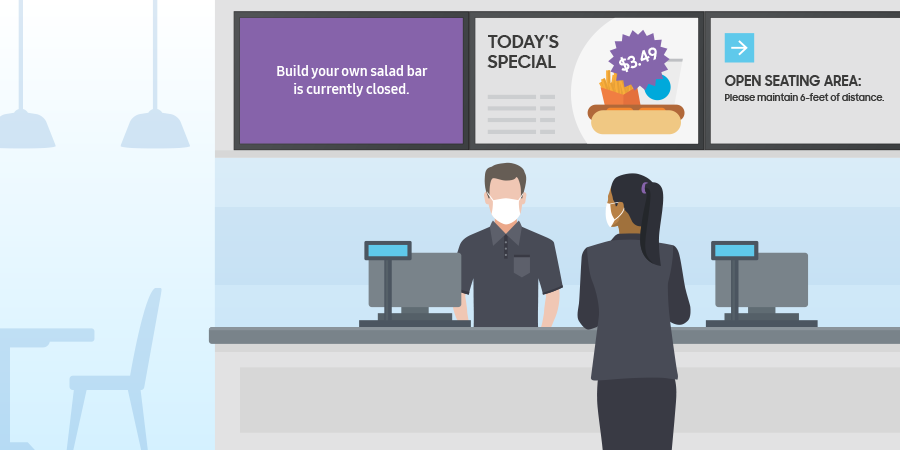
Back to business
Across all workplace touchpoints, screens, sensors and smart software can help businesses operate smartly and efficiently amid all these new norms.
Staffers and visitors, confronted with significant and steadily evolving change, need to be consistently informed and guided on what they should be doing differently and how to go about it.
Across a variety of applications, digital signage is also the most effective way to communicate a core message: The health and safety of your teams matter.
Learn more about integrating and deploying digital signage in business buildings in this free white paper. And discover 7 ways you can drive ROI with Samsung Pro TV.
